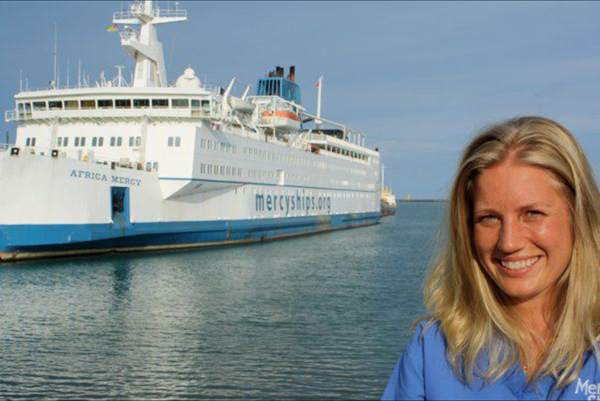By Judith Van Berkom –
Shannon de Haan, an operating nurse at the Civic campus of the Ottawa Hospital, spent a decade working toward her goal of volunteering on the Mercy Ship, an international, faith-based, charity that uses hospital ships to deliver transformational surgeries and health care to people around the world.
Hers is a story about making a difference, one person at a time, and the satisfaction of working selflessly to better the lives of those otherwise left to suffer and die.

A visiting pastor’s stories of work on the Mercy Ship sparked de Haan’s dream back in 2002. Originally from Chatham, Ontario where she completed her nursing training, de Haan worked on a post-operative floor in Moncton, New Brunswick for two years after graduation and moved to Ottawa, where her family had relocated, in 2006, to take a course as an operating room nurse. In nursing school, she kept her goal in mind of becoming an operating nurse. “That’s where everything is happening,” says de Haan, adding that it’s the best place to be as a nurse.
Having gained the needed training and experience, she applied for her first trip in 2012.
Mercy Ship originated in Texas and now has offices located all over the world. According to the Mercy Ship website, their work has directly benefitted over 2.48 million people.
Volunteering requires a lengthy application form, several references, and experience. Acceptance is also dependent on the specific surgical needs at the time since space is so limited. Nurses commit to a minimum of two weeks.
De Haan describes her fear of asking her boss for leave from her job at the Civic Hospital.
“It was very important to me,” she says. “Do I quit if she says no?”
Her boss agreed to give her time off. “It was a huge answer to prayer,” says de Haan. In 2014, under a different boss, she received the same, positive response and was able to volunteer for two months, this time in Madagascar.
“There are volunteers from all over the world,” says de Haan, adding that on her first volunteer experience – six months in 2012 – there were 45 different nationalities working together, English being the common spoken language. Local day workers are hired and paid by international donors mainly to translate on the ship. Many of the patients are children, unable to communicate in English.
Volunteers on the Mercy Ship, including doctors, surgeons, physiotherapists, teachers, engineers, and staff required to run a surgical ship – cooks, cleaners, plumbers, electricians – pay their room and board. Space is limited to 450 people.
De Haan shared a room with five other girls on her first trip, sleeping on bunk beds with one common bathroom.
“It’s great for meeting like-minded people,” she says. “The friends you meet are one of the best parts.” In fact, she is still friends with her bunkmate and travels regularly with a Swiss friend she met on the Mercy Ship – to Morocco, Madagascar, South Africa.
The Mercy Ship stays in a given port for eight months and travels to the Canary Islands to be refitted before going to the next location. Months ahead of time, volunteers work to secure patients in need, and space for the on-shore Hope Centre and Dental Clinic. The ship has five operating rooms, a CT scanner, an accredited school for grades one to 12, and five chaplains. As a charitable organization, they depend on donations. In the past, they had three ships, but didn’t have the funds to keep them up-to-date. A donation of $20 million is paying for a brand new ship to be built in China.
In addition to five operating rooms staffed with five surgeons, five anesthetists, and operating room nurses, a doctor works in a recovery room that accommodates 15 patients. These patients’ caretakers (usually a family member) sleep under the patient’s bed.
“It’s such a warm community,” de Haan explains, “a different world.”
One surgeon, specializing in cleft palate and other facial surgeries, has been on the Mercy Ship for 30 years. It’s where he met his wife and raised two children.
De Haan describes a memorable experience she had in 2012, in which she assisted during cataract surgery for a young girl. The girl – blinded by her condition – had never seen her mother. When the bandages were taken off her eyes, de Haan watched as the child saw her mother for the first time.
Many children arrive at the Mercy Ship with burns that become contractures (a permanent shortening of a muscle or joint). Volunteer plastic surgeons treat the contractures and free up the affected areas.
One young boy arrived with a large tumor under his chin. He had been ostracized from his community and was very isolated. He was slowly suffocating to death and his airway would eventually have closed off. It would have been a long, slow, horrifying death. The surgery to remove the benign tumor took 12 hours and the excised tumor weighed 7.4 kg. De Haan says he’d still be like that if it wasn’t for the Mercy Ship.
More information about Mercy Ships – including a blog and photos – is available at mercyships.ca.




